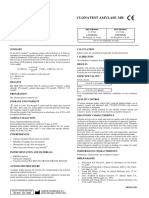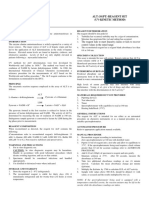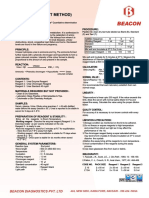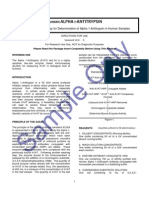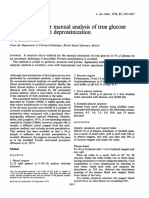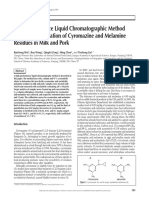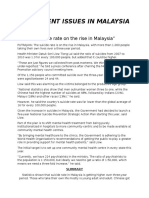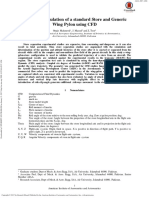ECAM
ECAM
Uploaded by
Lalit LekhwaniCopyright:
Available Formats
ECAM
ECAM
Uploaded by
Lalit LekhwaniCopyright
Available Formats
Share this document
Did you find this document useful?
Is this content inappropriate?
Copyright:
Available Formats
ECAM
ECAM
Uploaded by
Lalit LekhwaniCopyright:
Available Formats
BioAssay Systems Amylase ECAM003.
EnzyChromTM α-Amylase Assay Kit (ECAM-100)
Quantitative Colorimetric Amylase Determination at 585nm
DESCRIPTION
AMYLASE belongs to the family of glycoside hydrolase enzymes that 3. Add 150 µL Detection Reagent to each well. Mix and incubate for 20
break down starch into glucose molecules by acting on α-1,4- min at room temperature (25°C). Read OD585nm (540-610nm) on
glycosidic bonds. The α-amylases (EC 3.2.1.1) cleave at random a plate reader.
locations on the starch chain, ultimately yielding maltotriose and
maltose, glucose and "limit dextrin" from amylose and amylopectin. In
CALCULATION
mammals, α-amylase is a major digestive enzyme. Increased enzyme The Amylase activity is calculated as
levels in humans are associated with salivary trauma, mumps due to ODSAMPLE – ODBUFFER 400 × n
inflammation of the salivary glands, pancreatitis and renal failure. Activity = × (U/L)
ODSTD – ODBUFFER t (min)
Simple, direct and automation-ready procedures for measuring
amylase activity are very desirable. BioAssay Systems’ EnzyChrom
TM ODSAMPLE, ODSTD and ODBUFFER are optical density values of the
α-amylase assay method involves two steps: (1). α-amylase in the sample, the 400 µM glucose standard and Assay Buffer. t is the
sample hydrolyzes starch and the product is rapidly converted to incubation time. t = 15 min in the standard protocol. n is the dilution
glucose by α-glucosidase and hydrogen peroxide by glucose oxidase; factor (n = 50 for serum, 2000 for saliva). One unit of enzyme
(2). hydrogen peroxide concentration is determined with a colorimetric catalyzes the production of 1 µmole of glucose per min under the
reagent. assay conditions.
Note: if the calculated activity is higher than 50 U/L, dilute sample in
APPLICATIONS Assay Buffer and repeat assay. Multiply the results by the dilution
Direct assays of α-amylase activity in blood, saliva, urine, grains and factor.
other agricultural samples.
MATERIALS REQUIRED, BUT NOT PROVIDED
KEY FEATURES Pipeting devices, centrifuge tubes, clear flat-bottom 96-well plates,
Sensitive and accurate. Linear detection range 0.3 to 50 U/L α- plate reader, and optionally membrane filters (e.g. Microcon YM-10
amylase in 96-well plate assay. from Millipore).
Convenient. The procedure involves adding a single working reagent,
incubation for 15 min, followed by the detection reagent and a 20-min GENERAL CONSIDERARIONS
incubation and reading the optical density at 585 nm. For samples known to contain glucose, use a membrane filter (e.g.
Microcon YM-10 from Millipore) to remove glucose: load 50 µL sample in
KIT CONTENTS a Microcon YM-10 (10 kDa cutoff) and add 500 µL Assay Buffer.
Assay Buffer (pH 7.0): 20 mL Substrate: 120 µ L Centrifuge at 14000 rpm for 30 min, check level of sample, ideally the
Detection Reagent: 20 mL Enzyme A: 120 µ L sample level will be less than 50 µL. Add 500 µL Assay Buffer and
Glucose Standard: 1 mL Enzyme B: 120 µ L repeat the centrifugation. Measure final sample volume with a pipetman
and calculate dilution factor n = final sample volume/50 µL.
Storage conditions. Kit is shipped on ice. Store Detection Reagent at
4°C and others at -20°C. Shelf life of at least 6 months (see expiry
dates on labels).
Precautions: reagents are for research use only. Normal precautions 0.8
for laboratory reagents should be exercised while using the reagents. α -Amylase
Please refer to Material Safety Data Sheet for detailed information.
∆ OD585nm
0.6
PROCEDURES
Reagents. Equilibrate all components to room temperature. Keep
thawed Enzyme Mix in a refrigerator or on ice. The substrate may 0.4
have precipitates. Prior to use, vortex tube to dissolve precipitates; R2 = 1.00
gentle swirl the Detection Reagent bottle.
0.2
Sample preparation. Ideally samples are assayed fresh. When stored
frozen, α-amylase is stable for one month. Ascorbic acid, heparin,
EDTA, EGTA, citrate, SDS, Tris (> 8mM) and ethanol (>0.4%)
0.0
interfere and should be avoided in sample preparation. If glucose is 0 10 20 30 40 50
present in the sample, treat the samples as described in GENERAL
CONSIDERATIONS. It is prudent to perform a pilot test with samples α -Amylase (U/L)
at various dilutions. Recommended dilution: serum 50-fold, saliva
2,000-fold in Assay Buffer prior to assay. Standard Curve in 96-well plate assay
1. Prepare 400 µM Glucose Standard by mixing 10 µL of the provided
(300 mg/dL) standard with 406 µL Assay Buffer. Transfer 10 µL
Assay Buffer, 10 µL 400 µM glucose, and 10 µL of each sample LITERATURE
into separate wells of a clear flat-bottom 96-well plate. 1. Gullbault, GG and Rietz, E.B. (1976). Enzymatic, Fluorometric
Assay of a-Amylase in Serum. Clin. Chem. 22(10): 1702:1704.
2. Prepare an appropriate Working Reagent for each well. For
Standards and samples: mix 40 µL Assay Buffer, 0.5 µL Substrate, 2. Mashige F, Ohkubo A, Kamei S, Yamanaka M. (1982). An enzymic
method for urine and serum alpha-amylase assay. Clin. Chem.
1 µL Enzyme A, 1 µL Enzyme B.
28(7):1715-6.
Transfer 40 µL working reagent and blank control reagent to the 3. Marshall JJ, Iodice AP, Whelan WJ. (1977). A new serum alpha-
appropriate sample and blank wells. Tap plate to mix. Incubate for amylase assay of high sensitivity. Clin Chim Acta. 76(2):277-83.
15 min at room temperature (25°C).
2008 by BioAssay Systems · 3423 Investment Boulevard, Suite 11, Hayward, CA 94545, USA · Website: www.bioassaysys.com
Tel: 510-782-9988, Fax: 510-782-1588 · Email: order@bioassaysys.com, info@bioassaysys.com
Page 1 of 1
You might also like
- Α Α Α Α-Amylase-Eps: Biosystems S.ADocument1 pageΑ Α Α Α-Amylase-Eps: Biosystems S.ARisqon Anjahiranda AdiputraNo ratings yet
- Experimental approaches to Biopharmaceutics and PharmacokineticsFrom EverandExperimental approaches to Biopharmaceutics and PharmacokineticsNo ratings yet
- So Where Are You FromDocument1 pageSo Where Are You Fromapi-554523447No ratings yet
- 1.alpha AmylaseDocument2 pages1.alpha AmylaseHiếu Chí PhanNo ratings yet
- Ifu I Screen Amoz Rapid Hu0050035 en v01 06jan2023Document4 pagesIfu I Screen Amoz Rapid Hu0050035 en v01 06jan2023Hiệp Bình Sen đáNo ratings yet
- Mak 119 BulDocument2 pagesMak 119 Bul12099964No ratings yet
- Mak 009 BulDocument3 pagesMak 009 BulMohammad ZabehNo ratings yet
- Clonatest Amylase MRDocument4 pagesClonatest Amylase MRSuprovet LabotatorioNo ratings yet
- TFS Assets - BID - Manuals - EEA002 Manual Metabolic FinalDocument11 pagesTFS Assets - BID - Manuals - EEA002 Manual Metabolic FinaldewiNo ratings yet
- KR10060Document2 pagesKR10060KOUAME EDYMAIN FRANCISNo ratings yet
- SGOT CrestlineDocument2 pagesSGOT CrestlineJashmyn JagonapNo ratings yet
- Uric Acid: (Uricase / Pod Method)Document1 pageUric Acid: (Uricase / Pod Method)Dharmesh Patel100% (3)
- TBS2105 β Hexosaminidase Activity Assay 2022Document2 pagesTBS2105 β Hexosaminidase Activity Assay 2022Mónica Álvarez CórdobaNo ratings yet
- Enzymology: Practical Manual BIOC231Document40 pagesEnzymology: Practical Manual BIOC231Shubham SutarNo ratings yet
- Measure AmyDocument2 pagesMeasure Amytuan vănNo ratings yet
- A7564-01 - AmylaseDocument2 pagesA7564-01 - AmylaseSiva Kumar KNo ratings yet
- DFANDocument1 pageDFANA.j. CâmaraNo ratings yet
- ifu_i_screen_sem_rapid_hu0050036_en_v01_09jan2023Document4 pagesifu_i_screen_sem_rapid_hu0050036_en_v01_09jan2023Sâm Đặng Thị MỹNo ratings yet
- UREAUV SLR INSERTDocument1 pageUREAUV SLR INSERTventasmedicarescNo ratings yet
- ACCENT-200 AMYLASE ADocument2 pagesACCENT-200 AMYLASE Aemc.medicalserviceNo ratings yet
- 6.POTASSIUM EnzymaticDocument2 pages6.POTASSIUM EnzymaticHiếu Chí PhanNo ratings yet
- Alpha-AMYLASE BLOSR6x82 ENDocument4 pagesAlpha-AMYLASE BLOSR6x82 ENMeethuanNo ratings yet
- E BC K008 S ElabscienceDocument12 pagesE BC K008 S ElabscienceEmmanuel OwonaNo ratings yet
- ACCENT-200 ALPHA-FETOPROTEIN ADocument2 pagesACCENT-200 ALPHA-FETOPROTEIN Aemc.medicalserviceNo ratings yet
- GPTDocument2 pagesGPT徳利雅100% (1)
- FT - Urease Activity Assay KitDocument4 pagesFT - Urease Activity Assay KitPedroNo ratings yet
- Rabbit Alkaline Phosphatase (Alp) Elisa: K-AssayDocument7 pagesRabbit Alkaline Phosphatase (Alp) Elisa: K-AssayCristian CulcitchiNo ratings yet
- el-sayed2013 (1)Document15 pagesel-sayed2013 (1)g preethiNo ratings yet
- AmylaseDocument1 pageAmylasetuan vănNo ratings yet
- ALAT_(Cell Biolabs)Document8 pagesALAT_(Cell Biolabs)j.renaudmenangaNo ratings yet
- PI e UA - TOOS 19Document2 pagesPI e UA - TOOS 19labor baiturrahimNo ratings yet
- AstoDocument2 pagesAstoLAB. GATOT SUBROTONo ratings yet
- UREA Berthlot PDFDocument1 pageUREA Berthlot PDFDiegoNo ratings yet
- Determination of Molecular Weight Distribution and Average Molecular Weights of Oligosaccharides by HPLC With A Common C18 Phase and A Mobile Phase With High Water ContentDocument4 pagesDetermination of Molecular Weight Distribution and Average Molecular Weights of Oligosaccharides by HPLC With A Common C18 Phase and A Mobile Phase With High Water ContentTaurusVõNo ratings yet
- Alpha-Amylase: For In-Vitro Diagnostic and Professional Use OnlyDocument2 pagesAlpha-Amylase: For In-Vitro Diagnostic and Professional Use OnlyPark YuriNo ratings yet
- Amylase: Quantitative Determination of - Amylase (AMS)Document2 pagesAmylase: Quantitative Determination of - Amylase (AMS)Nolberto Robles100% (1)
- ALP Crestline PDFDocument2 pagesALP Crestline PDFJashmyn JagonapNo ratings yet
- Sandwich Immunoassay TechniqueDocument2 pagesSandwich Immunoassay Techniqueeldan.zhangirovNo ratings yet
- H Alpha 1 Antitrypsin: Immunoperoxidase Assay For Determination of Alpha 1-Antitrypsin in Human SamplesDocument4 pagesH Alpha 1 Antitrypsin: Immunoperoxidase Assay For Determination of Alpha 1-Antitrypsin in Human Samplesyunitaekawati1459No ratings yet
- ARG81296 ALP Alkaline Phosphatase Assay Kit 221028Document9 pagesARG81296 ALP Alkaline Phosphatase Assay Kit 221028Linh ĐỗNo ratings yet
- Crystallization and Biological Studies of Nypa Fruticans Wurmb SapDocument6 pagesCrystallization and Biological Studies of Nypa Fruticans Wurmb Sapratno TimurNo ratings yet
- Urea Color ENDocument1 pageUrea Color ENShakilur IslamNo ratings yet
- Activity 8 Uric AcidDocument1 pageActivity 8 Uric AcidJabez Lloyd AsedilloNo ratings yet
- Activity 4 CC2Document3 pagesActivity 4 CC22B VILORIA, Kristine Joyce D.No ratings yet
- Department Ofbiochemistry and Pharmacy, Abo Akademi, Porthansgatan 3, Sf-20500 Abo 50. FinlandDocument5 pagesDepartment Ofbiochemistry and Pharmacy, Abo Akademi, Porthansgatan 3, Sf-20500 Abo 50. FinlandAiims2k18 UG mbbsNo ratings yet
- Quanti Cation of Proteins by Bradford MethodDocument5 pagesQuanti Cation of Proteins by Bradford MethodsachithudaraNo ratings yet
- Micro Method For Manual Analysis of in Plasma Without DeproteinizationDocument3 pagesMicro Method For Manual Analysis of in Plasma Without DeproteinizationPojangNo ratings yet
- 25 2244700 Hach SdsDocument5 pages25 2244700 Hach Sdsajafri90No ratings yet
- HPLC CHina PDFDocument4 pagesHPLC CHina PDFIkari PoNo ratings yet
- SGPT CrestlineDocument2 pagesSGPT CrestlineJashmyn JagonapNo ratings yet
- Amylase in Honey 30602Document8 pagesAmylase in Honey 30602Тетяна КозицькаNo ratings yet
- Alp Mono VialsDocument3 pagesAlp Mono VialsN. K. MandilNo ratings yet
- Reagen DiaSys Asam UratDocument2 pagesReagen DiaSys Asam UratTammy NurhardiniNo ratings yet
- 174 - 13 UREA PDF - 28-Euro Procedure SheetDocument2 pages174 - 13 UREA PDF - 28-Euro Procedure SheetP VijayaNo ratings yet
- Budi Altgpt - Doc NewDocument3 pagesBudi Altgpt - Doc NewIrvanda ENVIOUSNo ratings yet
- Laboratory Activity No. 12 Blood Urea NitrogenDocument3 pagesLaboratory Activity No. 12 Blood Urea NitrogenSilverStormNo ratings yet
- Amylase enDocument1 pageAmylase enRakib Hossain 3A-159No ratings yet
- Technical Bulletin: Aspartate Aminotransferase (AST) Activity Assay KitDocument4 pagesTechnical Bulletin: Aspartate Aminotransferase (AST) Activity Assay KitbudiNo ratings yet
- ASO APT AbDocument2 pagesASO APT AbQC LabNo ratings yet
- 2011 Article 160Document6 pages2011 Article 160jwalantkbhattNo ratings yet
- Amylase Activity - Amylazym - HODocument4 pagesAmylase Activity - Amylazym - HOKasper DeflemNo ratings yet
- Research New Trends in AccountingDocument41 pagesResearch New Trends in AccountinglheyniiNo ratings yet
- Ec 0079Document7 pagesEc 0079Yousef KhayatNo ratings yet
- Msgtra ImssDocument3 pagesMsgtra Imsskokojumbo12No ratings yet
- Underground CableDocument23 pagesUnderground CableVinay KumarNo ratings yet
- BG Loudspeakers 2014Document136 pagesBG Loudspeakers 2014vpandza1No ratings yet
- Manduk Ya Upanishad at at Pary ADocument24 pagesManduk Ya Upanishad at at Pary ASauri ChaitanyaNo ratings yet
- Probability and StatisticsDocument4 pagesProbability and StatisticsNeils ArenósNo ratings yet
- Contract Advisory Notes - As-Built DrawingsDocument7 pagesContract Advisory Notes - As-Built Drawingsmuniandy0% (1)
- Greensight Active SafetyDocument64 pagesGreensight Active SafetyTomasz BedrunkaNo ratings yet
- Alkyl Amines KurkumbhDocument9 pagesAlkyl Amines KurkumbhVishvajit PatilNo ratings yet
- The Journey of A YogiDocument35 pagesThe Journey of A Yogikapnau007No ratings yet
- Instituto Mixto Miguel de Cervantes Saavedra English Guide Activity #3 Reading Comprehension Practice Read The Following TextDocument2 pagesInstituto Mixto Miguel de Cervantes Saavedra English Guide Activity #3 Reading Comprehension Practice Read The Following TextANDRESNo ratings yet
- Ewaq140g SsDocument5 pagesEwaq140g SsTofan VasileNo ratings yet
- Physics As - Unit 2 - Revision NotesDocument0 pagesPhysics As - Unit 2 - Revision NotesRimaz RameezNo ratings yet
- G20 Green Finance Synthesis Report - 5 September 2016Document35 pagesG20 Green Finance Synthesis Report - 5 September 2016Seni NabouNo ratings yet
- Gymnosperm: Acrogymnospermae, Are A Group ofDocument29 pagesGymnosperm: Acrogymnospermae, Are A Group ofBashiir NuurNo ratings yet
- Types of Lamps and LightingDocument52 pagesTypes of Lamps and LightingKevin Ndeti100% (1)
- Phy ATP (5054) Class 10Document57 pagesPhy ATP (5054) Class 10Maryam SiddiqiNo ratings yet
- V Model Advantages and Disadvantages - What Is V-Model? When and How To Use It?Merits and DemeritsDocument1 pageV Model Advantages and Disadvantages - What Is V-Model? When and How To Use It?Merits and DemeritsBrandon McleanNo ratings yet
- Third Spacing When Body Fluid Shifts.39Document4 pagesThird Spacing When Body Fluid Shifts.39Satriyo Dwi SuryantoroNo ratings yet
- Flirting Sex Train - I Accidentally Got On The Women-Only Car and Sex Is Allowed - Vol. 1Document133 pagesFlirting Sex Train - I Accidentally Got On The Women-Only Car and Sex Is Allowed - Vol. 1toeykaenmaihomNo ratings yet
- Le Bohec, Yann - The Encyclopedia of The Roman Army - Navy (2015, John Wiley & Sons, LTD) (10.1002 - 9781118318140.wbra1048) - Libgen - LiDocument7 pagesLe Bohec, Yann - The Encyclopedia of The Roman Army - Navy (2015, John Wiley & Sons, LTD) (10.1002 - 9781118318140.wbra1048) - Libgen - LiAC16No ratings yet
- 5 Current Issues in MalaysiaDocument8 pages5 Current Issues in MalaysiaNajwaNo ratings yet
- Alia Artical (X) COMPARATIVE STUDY OF AGGRESSION EFFECTS ON YOUNG AND ADULT ATHLETES IN Faisalabad PakistanDocument8 pagesAlia Artical (X) COMPARATIVE STUDY OF AGGRESSION EFFECTS ON YOUNG AND ADULT ATHLETES IN Faisalabad Pakistanalia chNo ratings yet
- John Cage: An Autobiographical StatementDocument8 pagesJohn Cage: An Autobiographical StatementnlNo ratings yet
- Preston Nichols - Pyramids of Montauk (Habla de Aleister Crowley)Document4 pagesPreston Nichols - Pyramids of Montauk (Habla de Aleister Crowley)cmdsoltecNo ratings yet
- Trajectory Simulation of A Standard Storedr Jahnzeb Masud 2Document12 pagesTrajectory Simulation of A Standard Storedr Jahnzeb Masud 2Abdullah IlyasNo ratings yet
- Lesson Plan GET GR 8 Creative Arts Visual Art T1 W 3, 4Document12 pagesLesson Plan GET GR 8 Creative Arts Visual Art T1 W 3, 4SnqobileNo ratings yet
- Paglalaan NG ma-WPS OfficeDocument4 pagesPaglalaan NG ma-WPS OfficeNikka ChavezNo ratings yet









